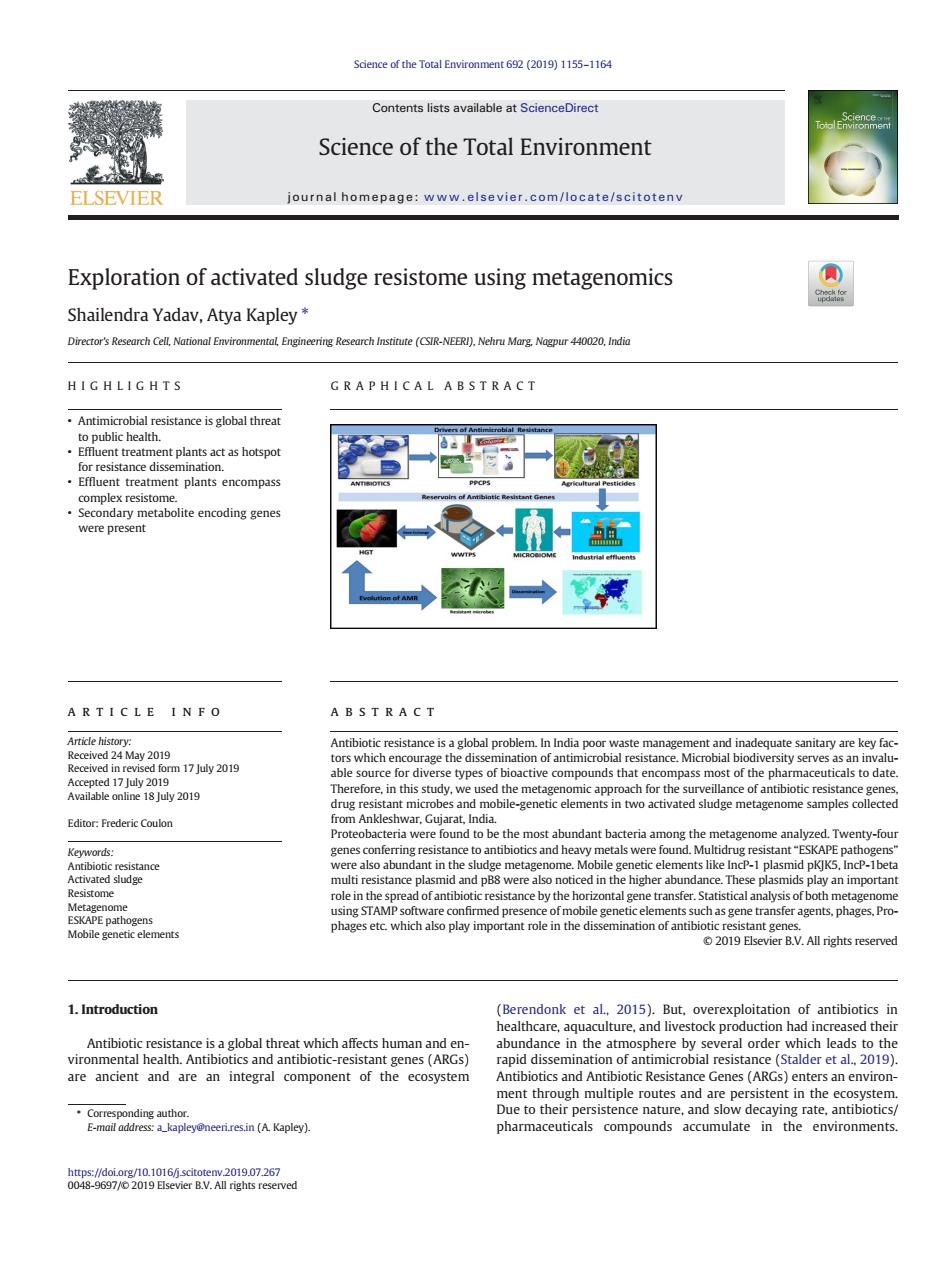正在加载图片...

Scerxe of the Total Emvireament 692 (2019)1155-1164 Contents lists available at ScicnceDirect Science of the Total Environment 亚 ELSEVIER journal homepage:www.elsevier.com/locate/scitotenv Exploration of activated sludge resistome using metagenomics Shailendra Yadav.Atya Kapley* e(IR-NEER)Nc HIcHLIGHTs GRAPHICAL ABSTRACT ts act as hotspot olite encoding genes @-+l-g ARTICLE INFO ABSTRACT Article histo 20 m17y201 e for div ds that ost of the pha ticals to dat AC18y209 Editor:Frederic Coulon nd p oticed in t (Berendonk) thcare. are ancient and are an integral component of the ecosystem pharmaceuticals compounds accumulate in the environments sg06v米amExploration of activated sludge resistome using metagenomics Shailendra Yadav, Atya Kapley ⁎ Director's Research Cell, National Environmental, Engineering Research Institute (CSIR-NEERI), Nehru Marg, Nagpur 440020, India HIGHLIGHTS • Antimicrobial resistance is global threat to public health. • Effluent treatment plants act as hotspot for resistance dissemination. • Effluent treatment plants encompass complex resistome. • Secondary metabolite encoding genes were present GRAPHICAL ABSTRACT article info abstract Article history: Received 24 May 2019 Received in revised form 17 July 2019 Accepted 17 July 2019 Available online 18 July 2019 Editor: Frederic Coulon Antibiotic resistance is a global problem. In India poor waste management and inadequate sanitary are key factors which encourage the dissemination of antimicrobial resistance. Microbial biodiversity serves as an invaluable source for diverse types of bioactive compounds that encompass most of the pharmaceuticals to date. Therefore, in this study, we used the metagenomic approach for the surveillance of antibiotic resistance genes, drug resistant microbes and mobile-genetic elements in two activated sludge metagenome samples collected from Ankleshwar, Gujarat, India. Proteobacteria were found to be the most abundant bacteria among the metagenome analyzed. Twenty-four genes conferring resistance to antibiotics and heavy metals were found. Multidrug resistant “ESKAPE pathogens” were also abundant in the sludge metagenome. Mobile genetic elements like IncP-1 plasmid pKJK5, IncP-1beta multi resistance plasmid and pB8 were also noticed in the higher abundance. These plasmids play an important role in the spread of antibiotic resistance by the horizontal gene transfer. Statistical analysis of both metagenome using STAMP software confirmed presence of mobile genetic elements such as gene transfer agents, phages, Prophages etc. which also play important role in the dissemination of antibiotic resistant genes. © 2019 Elsevier B.V. All rights reserved Keywords: Antibiotic resistance Activated sludge Resistome Metagenome ESKAPE pathogens Mobile genetic elements 1. Introduction Antibiotic resistance is a global threat which affects human and environmental health. Antibiotics and antibiotic-resistant genes (ARGs) are ancient and are an integral component of the ecosystem (Berendonk et al., 2015). But, overexploitation of antibiotics in healthcare, aquaculture, and livestock production had increased their abundance in the atmosphere by several order which leads to the rapid dissemination of antimicrobial resistance (Stalder et al., 2019). Antibiotics and Antibiotic Resistance Genes (ARGs) enters an environment through multiple routes and are persistent in the ecosystem. Due to their persistence nature, and slow decaying rate, antibiotics/ pharmaceuticals compounds accumulate in the environments. Science of the Total Environment 692 (2019) 1155–1164 ⁎ Corresponding author. E-mail address: a_kapley@neeri.res.in (A. Kapley). https://doi.org/10.1016/j.scitotenv.2019.07.267 0048-9697/© 2019 Elsevier B.V. All rights reserved Contents lists available at ScienceDirect Science of the Total Environment journal homepage: www.elsevier.com/locate/scitotenv